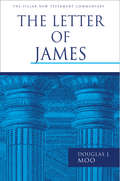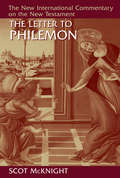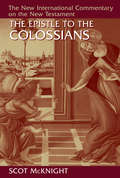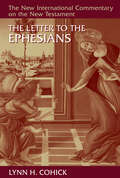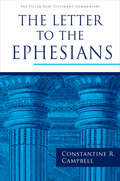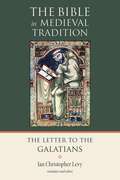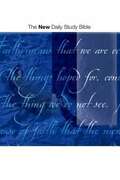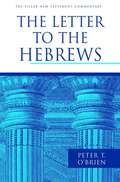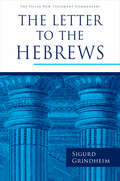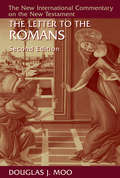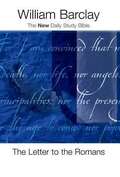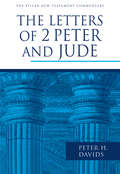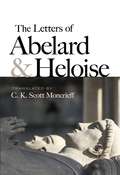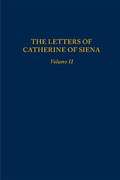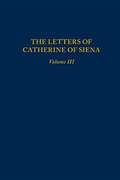- Table View
- List View
The Letter of James (The Pillar New Testament Commentary (PNTC))
by Douglas J. MooFew books in the New Testament are better known or more often quoted as the Letter of James. Because James is so concise, so intensely practical, and so filled with memorable metaphors and illustrations, it has become one of the two or three most popular New Testament books in the church.This highly original commentary seeks to make the Letter of James clear and applicable to Christian living today. Interacting with the latest views on James but keeping academic references to a minimum, Douglas Moo first introduces the Letter of James in its historical context and then provides verse-by-verse comments that explain the message of James both to its first readers and to today's church.
The Letter of James (The Pillar New Testament Commentary (PNTC))
by Douglas J. MooFew New Testament books have been as controversial and misunderstood as the letter of James. Its place in the canon was contested by some early Christians, and the reformer Martin Luther called it an &“epistle of straw.&” The sometimes negative view of the letter among modern theologians, however, is not shared by ordinary believers. Well known and often quoted, James is concise, intensely practical, and filled with memorable metaphors and illustrations. As such, it has become one of the most popular New Testament books in the church. This highly original commentary on James by respected New Testament scholar Douglas Moo combines penetrating scholarship with the simplicity of style and pastoral tone characteristic of James itself. After discussing such background issues as authorship, genre, purpose, structure, and theology, Moo provides a verse-by-verse exposition of the text that leads readers to the heart of James&’s message—wholehearted commitment to Christ. In addition to expounding the meaning of James, Moo also takes care to provide practical insights for applying that meaning in the church today. At once scholarly and accessible, this volume has become a standard commentary on James. The second edition is based upon the newest version of the NIV and incorporates the latest scholarship. It has been expanded, updated, and revised throughout.
The Letter to Philemon (The New International Commentary on the New Testament)
by Scot McKnightThe Academy of Parish Clergy&’s 2018 Top Five Reference Books for Parish Ministry Paul's letter to Philemon carries a strong message of breaking down social barriers and establishing new realities of conduct and fellowship. It is also a disturbing text that has been used to justify slavery. Though brief, Philemon requires close scrutiny. In this commentary Scot McKnight offers careful textual analysis of Philemon and brings the practice of modern slavery into conversation with the ancient text. Too often, McKnight says, studies of this short letter gloss over the issue of slavery—an issue that must be recognized and dealt with if Christians are to read Philemon faithfully. Pastors and scholars will find in this volume the insight they need to preach and teach this controversial book in meaningful new ways.
The Letter to Philemon (The New International Commentary on the New Testament)
by Scot McKnightThe Academy of Parish Clergy&’s 2018 Top Five Reference Books for Parish Ministry Paul's letter to Philemon carries a strong message of breaking down social barriers and establishing new realities of conduct and fellowship. It is also a disturbing text that has been used to justify slavery. Though brief, Philemon requires close scrutiny. In this commentary Scot McKnight offers careful textual analysis of Philemon and brings the practice of modern slavery into conversation with the ancient text. Too often, McKnight says, studies of this short letter gloss over the issue of slavery—an issue that must be recognized and dealt with if Christians are to read Philemon faithfully. Pastors and scholars will find in this volume the insight they need to preach and teach this controversial book in meaningful new ways.
The Letter to the Colossians (New International Commentary on the New Testament (NICNT))
by Scot McKnightThe Letter to the Colossians offers a compelling vision of the Christian life; its claims transcend religion and bring politics, culture, spirituality, power, ethnicity, and more into play. Delving deeply into the message of Colossians, this exegetical and theological commentary by Scot McKnight will be welcomed by preachers, teachers, and students everywhere.
The Letter to the Colossians (New International Commentary on the New Testament (NICNT))
by Scot McKnightThe Letter to the Colossians offers a compelling vision of the Christian life; its claims transcend religion and bring politics, culture, spirituality, power, ethnicity, and more into play. Delving deeply into the message of Colossians, this exegetical and theological commentary by Scot McKnight will be welcomed by preachers, teachers, and students everywhere.
The Letter to the Ephesians (New International Commentary on the New Testament (NICNT))
by Lynn H. CohickThe letter to the Ephesians provokes an array of interpretive questions regarding authorship, audience, date, occasion, purpose of writing, and the nature of its moral instruction—including its words addressed to slaves and masters. Interacting critically in an arena of intense debate, Lynn Cohick provides an exegetically astute analysis of the six chapters of Ephesians, offering an insightful account of the letter&’s theology and soteriology as she attends to its expansive prose and lofty vision of God&’s redemption. Cohick analyzes everything from the letter&’s description of the church and its appeals for discipleship to the complex relationship between Jews and gentiles within the text and in the broader cultural context. Her extensive knowledge of the social realities of women and families in the ancient world is also evident throughout. Historically sensitive and theologically rich, Cohick&’s commentary will be an abundant resource for a new generation of scholars, pastors, and lay leaders.
The Letter to the Ephesians (The Pillar New Testament Commentary (PNTC))
by Constantine R. CampbellA clear and comprehensive commentary on Paul&’s Letter to the Ephesians. In the latest Pillar New Testament Commentary, Constantine R. Campbell illuminates the Letter to the Ephesians with scholarly precision and pastoral warmth. In line with the christological concerns of the letter, Campbell calls special attention to its theme of union with Christ. His thorough analysis covers a breadth of topics, including salvation and grace, the glory of God, and the church and its mission. Aimed at students and scholars of the Pauline epistles, Campbell&’s commentary carefully explains each verse of Ephesians with attention to historical and linguistic context. Yet the commentary prioritizes imminent theological concerns and remains accessible to any serious reader of the New Testament.
The Letter to the Galatians (Medieval Bible Commentary series)
by Ian Christopher LevyThis work on Galatians is the inaugural volume in a significant new commentary series, The Bible in Medieval Tradition, which seeks to reconnect today's Christians with part of the church's rich tradition of biblical interpretation. Ian Christopher Levy has brought together six substantial commentaries on Galatians written between the ninth and the fourteenth centuries. Levy's clear, readable translations of these major texts -- previously unavailable in English -- are augmented by his in-depth introduction, which locates each author within the broad context of medieval scholarship.
The Letter to the Galatians: A Sri Lankan Commentary On Paul's Letter To The Galatians (New International Commentary on the New Testament (NICNT))
by David A. DeSilvaNew volume in a favorite Bible commentary seriesWriting a commentary on Galatians is a daunting task. Despite its relative brevity, this Pauline letter raises a number of foundational theological issues, and it has played a vital role in shaping Christian thought and practice over the centuries.In this replacement of Ronald Y. K. Fung&’s 1988 New International Commentary volume, David deSilva ably rises to the challenge, providing a coherent account of Galatians as a piece of strategically crafted communication that addresses both the immediate pastoral challenges facing Paul&’s converts in Galatia and the underlying questions that gave rise to them.Paying careful attention to the history, philology, and theology of the letter, and interacting with a wealth of secondary literature on both Galatians and the rest of the Pauline corpus, deSilva&’s exegetically sound commentary will serve as an essential resource for pastors and theological students.
The Letter to the Galatians: A Sri Lankan Commentary On Paul's Letter To The Galatians (New International Commentary on the New Testament (NICNT))
by David A. deSilvaNew volume in a favorite Bible commentary seriesWriting a commentary on Galatians is a daunting task. Despite its relative brevity, this Pauline letter raises a number of foundational theological issues, and it has played a vital role in shaping Christian thought and practice over the centuries.In this replacement of Ronald Y. K. Fung&’s 1988 New International Commentary volume, David deSilva ably rises to the challenge, providing a coherent account of Galatians as a piece of strategically crafted communication that addresses both the immediate pastoral challenges facing Paul&’s converts in Galatia and the underlying questions that gave rise to them.Paying careful attention to the history, philology, and theology of the letter, and interacting with a wealth of secondary literature on both Galatians and the rest of the Pauline corpus, deSilva&’s exegetically sound commentary will serve as an essential resource for pastors and theological students.
The Letter to the Hebrews
by William BarclayAt first glance, the letter to the Hebrews can seem difficult to comprehend, but William Barclay believed "that no New Testament book gives us such a glorious picture of Jesus Christ in all the splendor of his manhood and in all the majesty of his deity. " So, amplified by Barclay's keen and vibrant commentary, this ancient letter emerges from apparent obscurity to be a vital resource of encouragement for Christians today. For almost fifty years and for millions of readers, the Daily Study Bible commentaries have been the ideal help for both devotional and serious Bible study. Now, with the release of the New Daily Study Bible, a new generation will appreciate the wisdom of William Barclay. With clarification of less familiar illustrations and inclusion of more contemporary language, the New Daily Study Bible will continue to help individuals and groups discover what the message of the New Testament really means for their lives.
The Letter to the Hebrews (The Pillar New Testament Commentary (PNTC))
by Peter T. O'BrienIn this carefully crafted commentary Peter O'Brien distinctively harvests the results of recent scholarship on the letter to the Hebrews, especially in relation to the genre of the document and the flow of its discourse. This volume is purposely neither unduly technical nor unhelpfully brief. Its careful exegesis and exposition combined with its theological richness and warm devotion will fruitfully serve pastors, teachers, and students everywhere.
The Letter to the Hebrews (The Pillar New Testament Commentary (PNTC))
by Sigurd GrindheimWhat does the Letter to the Hebrews have to say to Christians today?A compelling exhortation to hold true to the faith in the face of adversity. A sermon rife with iconic imagery and Old Testament allusions. A signal work of theology in the New Testament.Above all, the Letter to the Hebrews proclaims the high priesthood of Jesus Christ. But the book&’s textual complexity and long history of interpretation can be overwhelming. In this new Pillar commentary, Sigurd Grindheim illuminates the Letter to the Hebrews, paying careful attention to linguistic features and historical context—all while centering its relevance to modern readers.Grindheim clearly and comprehensively addresses major issues about the text, including authorship, date, canonicity, formal qualities, and major themes. Following his thorough introduction, he explains each line of the text and its significance for believers today. Grindheim&’s commentary offers pastors, students, and scholars the clarity and fresh insights they want in their scriptural study.
The Letter to the Philippians (The Pillar New Testament Commentary (PNTC))
by G. Walter HansenIn this commentary G. Walter Hansen offers rich exposition of the text of Philippians as well as wisdom and maturity in its application. In so doing he emphasizes partnership--the social and corporate dimensions of community--in the progress of the gospel. After a select bibliography, Hansen's introduction sets forth the historical setting of the church in Philippi, the nature and occasion of the letter, and a preview of two key themes--the gospel of Christ and the community in Christ. The commentary itself discusses Philippians in light of these themes, considering Paul's greetings, reports of gospel ministry, imperatives for citizens worthy of the gospel, recommendations of two Christ-like servants, and disclosures of his personal experience. Hansen's treatment as a whole is distinctive for the way it draws out and highlights the themes of partnership, citizenship, and friendship in Paul's Philippian letter. "With themes and emotions so varied, the letter to the Philippians needs a commentator with a sure grasp and a warm heart. . . . Hansen writes with admirable clarity and simplicity, even when he is unpacking notoriously complex matters." -- D. A. Carson (from the preface)
The Letter to the Romans (The Bible in Medieval Tradition (BMT))
by Ian Christopher Levy Philip Krey Thomas F. RyanThis is the second volume of The Bible in Medieval Tradition (BMT), a series that aims to reconnect the church with part of its rich history of biblical interpretation.Ian Levy, Philip Krey, and Thomas Ryan's Letter to the Romans presents the history of early and medieval interpretations of Romans and gives substantial translations of select medieval commentaries. Written by eight representative medieval interpreters between the ninth and fourteenth centuries, these commentaries have never been translated into English before.This valuable book will enhance contemporary reading of the Bible even as it lends insight into medieval scholarship. As Levy says, the medieval commentaries exhibit "qualities that many modern commentaries lack: a spiritual depth that reflects their very purpose, namely, to read Holy Scripture within the sacred tradition under the guidance of the Holy Spirit."
The Letter to the Romans: A Short Commentary
by Frederick Dale BrunerIn the wake of his widely appreciated commentaries on the Gospel of Matthew and the Gospel of John, noted theologian and exegete Frederick Dale Bruner turns his attention to Paul&’s letter to the Romans. In this concise commentary, he relays his findings on what he calls the &“Fifth Gospel&” and its central claim that &“through the Father&’s love, Jesus&’s passion, and the Spirit&’s application of this passionate love, human beings can have a perfectly right relationship with God—by simple faith in His Christ.&” As he did in his commentaries on Matthew and John, Bruner engages historical interpreters from the patristic period to the present—including Augustine, Chrysostom, Aquinas, Luther, and Calvin—while also offering his own lucid translation of the text and relevant pastoral applications. The result is a holistic understanding of the book of Romans informed not only by one scholar&’s lifetime of ministry, teaching, and learning, but also by the full depth and breadth of church tradition.
The Letter to the Romans: Second Edition (New International Commentary on the New Testament (NICNT))
by Douglas J. MooFor more than twenty years Douglas Moo&’s NICNT volume on Romans has been providing pastors, students, and scholars with profound insight into Paul&’s most famous letter. In this thorough revision of his commentary, Moo deals with issues that have come into prominence since the first edition (1996), incorporating the latest research and rewriting the text throughout for better comprehension.Exegetically astute and theologically minded, Moo interacts critically with the new perspective on Paul, highlights the emphasis in Romans on &“practical divinity,&” and traces the theme of the gospel throughout the letter. His Letter to the Romans in this second edition will inform and enlighten a new generation of serious Bible readers.
The Letter to the Romans: Second Edition (New International Commentary on the New Testament (NICNT))
by Douglas J. MooFor more than twenty years Douglas Moo&’s NICNT volume on Romans has been providing pastors, students, and scholars with profound insight into Paul&’s most famous letter. In this thorough revision of his commentary, Moo deals with issues that have come into prominence since the first edition (1996), incorporating the latest research and rewriting the text throughout for better comprehension.Exegetically astute and theologically minded, Moo interacts critically with the new perspective on Paul, highlights the emphasis in Romans on &“practical divinity,&” and traces the theme of the gospel throughout the letter. His Letter to the Romans in this second edition will inform and enlighten a new generation of serious Bible readers.
The Letter to the Romans: The New Daily Study Bible
by William BarclayNOW IN AN ENLARGED PRINT EDITION! In ways that no other writing of the New Testament has achieved, the ideas expressed in the letter to the Romans have shaped formatively the whole of Christian belief. William Barclay's fresh translation and clear exposition allows readers the chance to see the heart of Paul's gospel. For almost fifty years and for millions of readers, the Daily Study Bible commentaries have been the ideal help for both devotional and serious Bible study. Now, with the release of the New Daily Study Bible, a new generation will appreciate the wisdom of William Barclay. With clarification of less familiar illustrations and inclusion of more contemporary language, the New Daily Study Bible will continue to help individuals and groups discover what the message of the New Testament really means for their lives.
The Letters of 2 Peter and Jude (The Pillar New Testament Commentary (PNTC))
by Peter H. DavidsFilling a notable gap in scholarship on 2 Peter and Jude, Peter Davids artfully unpacks these two neglected but fascinating epistles that deal with the confrontation between the Greco-Roman world and the burgeoning first-century Jesus communities. Davids firmly grasps the overall structure of these oft-maligned epistles and presents a strong case for 2 Peter and Jude as coherent, consistent documents. Marked by exceptional exegesis and sharp, independent judgments, Davids's work both connects with the latest scholarship and transforms scholarly insights into helpful conclusions benefiting Christian believers.
The Letters of Abelard and Heloise
by M. T. Clanchy Betty RadiceThe story of the relationship between Abelard and Heloise is told through the letters of Peter Abelard, a French philosopher and one of the greatest logicians of the twelfth century, and of his gifted pupil Heloise. Through their impassioned writings unfolds the story of a romance, from its reckless, ecstatic beginnings through to public scandal, an enforced marriage and its devastating consequences. They also offer insight into religious life in the Middle Ages. This is the revised edition of Betty Radice's translation, in which Michael Clanchy, the biographer of Abelard, updates the scholarship on the letters and the lovers. This volume includes Abelard's autobiography and his spiritual advice to Heloise and her nuns, as well as a selection of the 'lost love letters' of Abelard and Heloise, letters between Heloise and Peter the Venerable, two of Abelard's hymns, a chronology, notes and maps.
The Letters of Abelard and Heloise
by C. K. MoncrieffAbelard, a prominent twelfth-century theologian, is hired to tutor Heloise, a brilliant pupil who becomes his lover and the mother of his child. Although the two are secretly married, a misunderstanding leads to Abelard's castration by Heloise's uncle, followed by the lovers' permanent separation. Abelard retreats to a monastery and Heloise to a nunnery — and their subsequent correspondence captured the romantic imaginations of generations of readers. The letters offer insights into the thinking of Abelard, who ranks among the Middle Ages' foremost philosophers, and the spirited determination of Heloise, an early feminist. They have also excited ongoing controversy in terms of their historical content and significance. Translator C. K. Scott Moncrieff takes a modern approach to the correspondence, adding new significance to its reflection of medieval attitudes toward love, marriage, and religion.
The Letters of Catherine of Siena (Volume #2)
by Catherine Of SienaThe second volume takes up Catherine's (1347-80) letters in February 1376, as she is making plans for her mission to the pope in Avignon. They continue through that trip to Florence and Avignon and back, time back in Siena and Belcaro, and her mission to the Val D'Orcia, and end in November or December 1377. Each chronological section and each letter itself is introduced, often at some length. An appendix identifies people she mentions or are mentioned in the introductions, and refers by number to all the letters in the volume that mentions them. Translation, notes and introduction by Suzanne Noffke.
The Letters of Catherine of Siena (Volume #3)
by Catherine Of SienaTranslation, notes and introduction by Suzanne Noffke.
